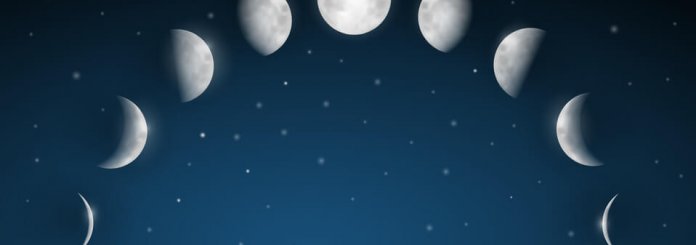The Lunar Cycles – A Guide Exploring the Phases of the Moon

The moon may just seem like a chunk of rock orbiting around Earth. The truth is that the moon is a very powerful object. Without its gravitational pull, many aspects of our life would cease to exist. Of course, looking at it from a spiritual standpoint, the moon has a lot more to offer.
The energy levels that irradiate from the moon are directly influenced by its cycle and phases. As such, we will explore the lunar cycles as a whole and delve deeper into some more specific aspects of the complete lunar cycle.
What is a Lunar Cycle?
We’ll start off with the basics: so what is a lunar cycle? A lunar cycle is a term given to the orbit of the moon around the Earth. A full lunar cycle takes roughly 29.5 days to complete and within the lunar cycles, we have the phases of the moon.
During the lunar cycle, there are 4 principal phases: new moon, first quarter, full moon, and third/last quarter. However, there are also intermediate phases of the moon. These include a waxing crescent, waxing gibbous, waning gibbous and waning crescent.
You may be wondering which phase of the moon follows the full moon phase. Well, a complete list in order for a full lunar cycle goes: new moon, waxing crescent, first quarter, waxing gibbous, full moon, waning gibbous, final quarter, waning crescent and back to a new moon.
These phases are based on the area of the moon exposed by the sun’s light. This, in turn, is a direct result of the positioning of the moon in relation to both the sun and the Earth. One of the many reasons that energy levels fluctuate so much based on which phase the moon is currently in.
Your Guardian Angel can help guide you towards this level of spiritual growth and knowledge! Would you like to know who your Protective Guardian Angel is?
In order to get in contact with your Guardian Angel and receive your FREE ANGEL READING, please fill out this form:
Why is it Called a Waxing Moon?
There are some terms you may be a little curious about. A common question that crops up in relation to the lunar cycles is why is it called a waxing moon? The term waxing comes from the verb to wax. This is often used as a synonym for “grow” and the term itself means to increase in size gradually.
Similarly, a waning moon comes from the verb “to wane” which means to decrease in size gradually. One term that throws many people off is gibbous. When something is gibbous, it is convex, rounded, or protuberant.
Other terms you may come across include an angel moon or the angel’s world of cycles. These have no meaning beyond what others have applied to them.
The Lunar Cycles – Complete Energy Guide
We’ll now take some time to explore the energy levels and how to interact with them during each of the phases. Rather than repeat the same steps for each one, know that meditation can be carried out at any point of the lunar cycle to a slightly different effect.
We will instead explore the elements of each phase specific to that part of the lunar energy flow. Paying attention to the lunar cycles can be an incredibly beneficial practice. For starters, it syncs up your energy with a celestial body which not only sounds cool but actually has profound spiritual benefits.
Following the lunar cycles is like keeping time with a novelty-sized watch. There is no better way to keep to the rhythm of the natural world and the all-encompassing universe than to use an orbital path such as this.
We’ll start at the very beginning (a new moon) and work our way around through the major energy points that you may wish to pay attention to.
New Moon
There are several important aspects of a new moon. For starters, it signifies a new beginning and can be symbolic of change within you. If you’re making any major changes in your life, choosing to begin during a new moon allows you to set your spirit up for what is to come.
During the new moon phase, you can’t see any part of the moon. This in itself is remarkable and spectacular as it allows you to look out into the night’s sky and see the vastness of space with galaxies, stars, planets, and maybe a comet or two. There really is nothing more humbling.
Waxing Moon
As the moon appears as a tiny slither and begins to increase in size, we too can begin to feel our energies increase along with it. If you’ve used the new moon is a time of rebirth or change, then the waxing stage symbolizes the building up of momentum as you continue with these personal alterations.
Change can be hard but think of yourself as the moon, aiming to be that giant, glowing disk that lights up the night’s sky.
Full Moon
During this phase, the moon draws all attention away from other celestial bodies. All the stars in the night’s sky seem a little dimmer in comparison to the radiant glow of the full moon. If you’ve stuck to your recent changes then perhaps this is also how you feel.
Take some time during this phase to look back through recent weeks and make a note of what you’ve accomplished. Even if you fell short of your goals, that’s perfectly fine. Make a note of what you’d try differently. There is always next month to make up for any mistakes or failed attempts.
Waning Moon
The waning moon may seem like a sadder stage of the lunar cycles but in actuality, it’s not. The sky may be getting darker with each passing night but just remember that much like the mighty phoenix, the moon will be reborn.
That’s also a trait that you should apply to yourself. If you’ve succeeded in making positive changes to your life then that’s great. Use this time to make a note of how you’d like to improve. If you didn’t do so well then you’ll be glad to hear that the new moon and the new energy that it offers allow you to try again.

